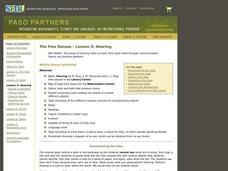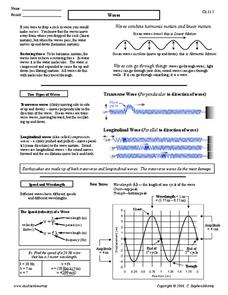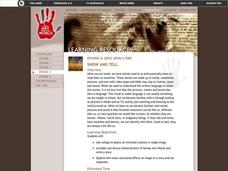Curated OER
Hearing
Students explore how the sense of hearing helps us learn from each other through communication. Sound can produce patterns.
Curated OER
High or Low
In this wave properties instructional activity, students will experiment to see how the sound made by vibrating a ruler is affected by the length of the part that is vibrating. Then students will answer 5 questions based on the results...
Curated OER
Make a Word: Long U by Starfall
Students explore language arts by participating an on-line grammar activity. In this letter U lesson, students discuss the uses for the letter U in the English language and the different sounds that can be made from the vowel. Students...
Curated OER
Lesson Plans for Sweet Dreams: How Animals Sleep
Students explore the sleeping patterns and sleeping habitats of animals. In this where animals sleep lesson, students research different animal species. Students also write and illustrate an animal picture book, make connections...
Curated OER
Vacuuming the V's
Students exercise the skill of phoneme awareness with vocal gestures to create the sound of /v/. They review the way to print the letter "V," how to form the /v/ sound and create a hand gesture to help them recall the vocal gesture of...
Curated OER
Designing Musical Instruments
Students examine musical instruments as main part of the study of sound energy. In this designing instruments lesson plan, students focus on the elements of an instrument that cause sound to be created and design a unique musical...
Curated OER
How Electric Current Produces Energy
Fifth graders are introduced to the concept of electric currents. In groups, they develop their own game board to test different circuits to determine if they are complete. They record their observations of the energy transfer between...
Curated OER
Teaching Phonics Through Poetry
Students understand rhythm and rhyming words in poetry. In this poetry lesson, students listen to poetry and are able to find the ABAB pattern. Students recognize the "ow" sound. Students complete various activities to practice the...
Curated OER
Hear No Evil
Students explore the function of the ears. For this sense of hearing lesson, students read the book Polar Bear, Polar Bear What Do You Hear and discuss the things the Polar Bear heard. Students construct simple musical instruments and...
Curated OER
Waves
In this waves worksheet, students read about the different types of waves and how the speed of waves is calculated. Then students complete 5 matching, 8 fill in the blank, and 9 short answer questions.
Curated OER
Getting the Message: What Did You Say?
Learners listen to and compare the first sentence of the Gettysburg Address spoken in different languages. They also compare frequency readings for each and discuss how the brain interprets spoken words.
Curated OER
Music from the Silk Roads
Learners explore different types of musical instruments. For this musical instrument lesson, students create a replica of a sheng. Learners utilize this instrument to understand different types of breathing used in different sounds....
Curated OER
the Little Red Riding Hood
Young scholars respond to the story of Little Red Riding Hood. In this Red Riding Hood instructional activity, students retell and discuss story elements. Young scholars practice phonic sounds. Students role play, make...
Curated OER
Senses of Taste and Smell
Students perform experiments to learn about their sense of taste and smell. In this taste and smell lesson, students watch as a blindfolded student tries to identify sounds and the direction they originate from. Students...
Curated OER
Popcorn PPPPopping P
Students are introduced to the most popular phonemes to help them with their reading. As a class, they listen to popcorn popping and identify the sound being heard. They practice saying different tongue twisters and drawing the letters...
Curated OER
Applied Science - Science and Math Lab
Students explore the senses. In this Applied Science lesson, students investigate the items in "feely" boxes with their hands, both touching the items and shaking the boxes to hear the sound the items make. Students also smell and taste...
Curated OER
Lesson Plan Seven: Sensorama
Students identify five senses, and use their senses of touch, sight, hearing, smell, and taste to distinguish different objects, sounds, smells and tastes, and write their answers in the booklet.
Curated OER
The Five Senses - Magic School Bus
Students identify five senses, draw parts of body that relate to each of the senses, hear different sounds in the environment, write those experiences in their journals, and list at least four objects/things that relate to each of the...
Curated OER
Once Upon a Time
Students examine how music and sound affect their creation of artwork. They view art images online, create three hybrid collage creatures, develop a list of hero characteristics, and write an adventure story for a character they have...
Curated OER
Collisions and Momentum: Bouncing Balls
Students explore the concepts of potential and kinetic energy by bouncing assorted balls on different surfaces and calculating the momentum for each ball. They give examples of collisions and momentum in sports and understand that...
Curated OER
Physics 210 - Frequency
In this frequency activity, students use the speed of sound to determine the frequency in which sounds are heard in 5 different word problems.
Curated OER
Science Charades
Students dramatize the wonderful world of nature, without making a sound. For this early childhood creative thinking lesson, students dramatize different aspects of nature to develop creative thinking, reading, memory, and motor skills.
Curated OER
American Rhythms
Students combine elements of music with poetry. In this creative writing lesson, students examine poems from a variety of authors with varying writing styles. Students explore the different elements of poetry, including tone,...
Curated OER
The Sense of Hearing
High schoolers study the cycle of how we listen and hear our own speech. They examine sound waves, and the role of the nervous system in hearing. They investigate the cues besides lipreading that deaf people rely on for comprehension.























